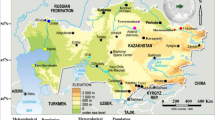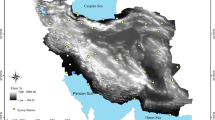Abstract
Temperature data from 29 synoptic stations in Iran for a period of 40 years (1966–2005) were analyzed to test for the existence of monotonic trends and shift changes in the annual, seasonal, and monthly mean air temperature series using the Mann–Kendall and Mann–Whitney tests. The influences of significant lag-1 serial correlation were eliminated from data by the trend-free pre-whitening method prior to the trend analysis. The magnitude of the temperature trends was derived from the Theil–Sen’s slope estimator. It was found that annual mean air temperature increased at 25 out of the 29 stations, of which 17 stations showed significant monotonic trends. The magnitude of the annual mean air temperature trends averagely was (+)0.224°C per decade. Most of the stations with the significant positive monotonic trends had a significant upward shift change. The analysis indicated that the change point year of the significant upward shift changes was 1972 for the whole stations except the coastal ones. Moreover, the strongest monotonic increasing trends and upward shift changes were observed in summer especially in August and September. The spatial analysis of the mean air temperature trends revealed the highest numbers of significant monotonic trends in the big cities of Iran. These findings provide more insights for better understanding of regional temperature behavior in the study area.







Similar content being viewed by others
References
Alijani B (1997) Some statistical characteristics of temperature variations in Iran. J Res Geogr 31:24–33
Andrighetti M, Zardi D, Franceschi M (2009) History and analysis of the temperature series of Verona (1769–2006). Meteorol Atmos Phys 103:267–277
Aziz OIA, Burn DH (2006) Trends and variability in the hydrological regime of the Mackenzie River Basin. J Hydrol 319(1–4):282–294
Box JE (2002) Survey of Greenland and instrumental temperature records: 1873–2001. Int J Climatol 22:1829–1847
Dinpashoh Y, Jhajharia D, Fakheri-Fard A, Singh VP, Kahya E (2011) Trends in reference crop evapotranspiration over Iran. J Hydrol 399:422–433
Domonkos P, Tar K (2003) Long-term changes in observed temperature and precipitation series 1901–1998 from Hungary and their relations to larger scale changes. Theor Appl Climatol 75:131–147
Feidas H, Makrogiannis T, Bora-Senta E (2004) Trend analysis of air temperature time series in Greece and their relationship with circulation using surface and satellite data: 1955–2001. Theor Appl Climatol 79:185–208
Gadgil A, Dhorde A (2005) Temperature trends in twentieth century at Pune, India. Atmos Environ 39:6550–6556
Ghahraman B (2006) Time trend in the mean annual temperature of Iran. Turk J Agric For 30:439–448
Ghasemi AR, Khalili D (2006) The influence of the Arctic Oscillation on winter temperatures in Iran. Theor Appl Climatol 85:149–164
Ghasemi AR, Khalili D (2008) The effect of the North Sea–Caspian pattern (NCP) on winter temperatures in Iran. Theor Appl Climatol 92:59–74
Goodrich JD (1992) Urban bias influences on long-term California air temperature trends. Atmos Environ 26:1–7
Hasanean HM (2001) Fluctuations of surface air temperature in the Eastern Mediterranean. Theor Appl Climatol 68:75–87
IRIMO (2007) Iranian Meteorological Office, Data Processing Center, Tehran, Iran
Jhajharia D, Dinpashoh Y, Kahya E, Singh VP, Fakheri-Fard A (2011) Trends in reference evapotranspiration in the humid region of northeast India. Hydrol Process. doi:10.1002/hyp.8140
Kiely G (1999) Climate change in Ireland from precipitation and streamflow observations. Adv Water Resour 23:141–151
Kohler MA (1949) Double-mass analysis for testing the consistency of records and for making adjustments. Bull Amer Meteor Soc 30:188–189
Kousari MR, Ekhtesasi MR, Tazeh M, Saremi Naeini MA, Asadi Zarch MA (2011) An investigation of the Iranian climatic changes by considering the precipitation, temperature, and relative humidity parameters. Theor Appl Climatol 103(3–4):321–335
Kumar S, Merwade V, Kam J, Thurner K (2009) Streamflow trends in Indiana: effects of long term persistence, precipitation and subsurface drains. J Hydrol 374(1–2):171–183
Masih I, Uhlenbrook S, Maskey S, Smakhtin V (2011) Streamflow trends and climate linkages in the Zagros Mountains, Iran. Clim Change 104:317–338
Moradi HR (2004) The effects of NAO index on climate of Iran. Geog Res 48:17–30 (in Persian with English abstract)
Novotny EV, Stefan HG (2007) Stream flow in Minnesota: indicator of climate change. J Hydrol 334(3–4):319–333
Oguntunde PG, Abiodun BJ, Lischeid G (2011) Rainfall trends in Nigeria, 1901–2000. J Hydrol. doi:10.1016/j.jhydrol.2011.09.037
Sabziparvar AA, Parandeh A, Lashkari H, Yazdanpanah H (2010) Mid-level synoptic analysis of flood-generating systems in South-west of Iran (case study: Dalaki watershed river basin). Nat Hazards Earth Syst Sci 10:2269–2279
Sadeghi AR, Kamgar-Haghighi AA, Sepaskahah AR, Khalili D, Zand-Parsa S (2002) Regional classification for dryland agriculture in southern Iran. J Arid Environ 50:333–341
Sen PK (1968) Estimates of the regression coefficient based on Kendall’s tau. J Am Stat Assoc 63(324):1379–1389
Soltani A, Gholipoor M (2006) Teleconnections between El Nino/southern oscillation and rainfall and temperature in Iran. Int J Agric Res 6:603–608
Soltani E, Soltani A (2008) Climatic change of Kh orasan, North-East of Iran, During 1950–2004. Res J Environ Sci 2(5):316–322
Tabari H, Hosseinzadeh Talaee P (2011a) Temporal variability of precipitation over Iran: 1966–2005. J Hydrol 396:313–320
Tabari H, Hosseinzadeh Talaee P (2011b) Recent trends of mean maximum and minimum air temperatures in the western half of Iran. Meteor Atmos Phys 111:121–131
Tabari H, Marofi S (2011) Changes of pan evaporation in the west of Iran. Water Resour Manag 25:97–111
Tabari H, Marofi S, Ahmadi M (2010) Long-term variations of water quality parameters in the Maroon River, Iran. Environ Monitor Assess 177:273–287
Tabari H, Marofi S, Aeini A, Hosseinzadeh Talaee P, Mohammadi K (2011a) Trend analysis of reference evapotranspiration in the western half of Iran. Agric For Meteorol 151:128–136
Tabari H, Shifteh Somee B, Rezaeian Zadeh M (2011b) Testing for long-term trends in climatic variables in Iran. Atmos Res 100:132–140
Theil H (1950) A rank invariant method of linear and polynomial regression analysis, Part 3. Netherlands Akademie van Wettenschappen, Proceedings 53:1397–1412
Turkes M, Sumer UM (2004) Spatial and temporal patterns of trends and variability in diurnal temperature ranges of Turkey. Theor Appl Climatol 77:195–227
Ventura F, Rossi Pisa P, Ardizzoni E (2002) Temperature and precipitation trends in Bologna (Italy) from 1952 to 1999. Atmos Res 61:203–214
von Storch H (1995) Misuses of statistical analysis in climate research. In: Storch HV, Navarra A (eds) Analysis of climate variability: applications of statistical techniques. Springer, Berlin, pp 11–26
Xu ZX, Takeuchi K, Ishidaira H (2003) Monotonic trend and step changes in Japanese precipitation. J Hydrol 279:144–150
Yue S, Hashino M (2003) Temperature trends in Japan: 1900–1996. Theor Appl Climatol 75:15–27
Yue S, Wang CY (2002) The influence of serial correlation on the Mann–Whitney test for detecting a shift in median. Adv Water Resour 25:325–333
Yue S, Pilon P, Phinney R, Cavadias G (2002) The influence of autocorrelation on the ability to detect trend in hydrological series. Hydrol Process 16:1807–1829
Yue S, Pilon P, Phinney R (2003) Canadian streamflow trend detection: impact of serial and cross-correlation. Hydrol Sci J 48(1):51–63
Acknowledgments
The authors would like to thank the Islamic Republic of Iran Meteorological Organization (IRIMO) for the air temperature data. Helpful comments from two anonymous referees are greatly appreciated.
Author information
Authors and Affiliations
Corresponding author
Rights and permissions
About this article
Cite this article
Tabari, H., Hosseinzadeh Talaee, P., Ezani, A. et al. Shift changes and monotonic trends in autocorrelated temperature series over Iran. Theor Appl Climatol 109, 95–108 (2012). https://doi.org/10.1007/s00704-011-0568-8
Received:
Accepted:
Published:
Issue Date:
DOI: https://doi.org/10.1007/s00704-011-0568-8




